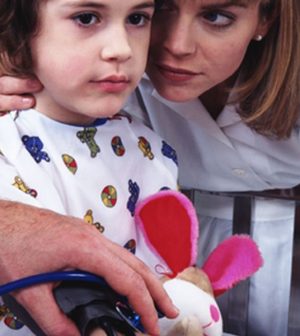- Navigating Your Midlife Crisis: Embracing New Possibilities
- City Raccoons Showing Signs of Domestication
- Mapping the Exposome: Science Broadens Focus to Environmental Disease Triggers
- One Week Less on Social Media Linked to Better Mental Health
- Your Brain Changes in Stages as You Age, Study Finds
- Some Suicide Victims Show No Typical Warning Signs, Study Finds
- ByHeart Formula Faces Lawsuits After Babies Sickened With Botulism
- Switch to Vegan Diet Could Cut Your Greenhouse Gas Emissions in Half
- Regular Bedtime Does Wonders for Blood Pressure
- Dining Alone Could Mean Worse Nutrition for Seniors
A Movie Instead of Anesthesia for Kids’ Radiation Therapy

For children with cancer, watching movies during radiation therapy might eliminate their need for general anesthesia, a new study suggests.
Kid-friendly movies such as “SpongeBob SquarePants” and “Cars” helped reduce the risks, trauma and costs of treatment for kids evaluated in the small European study.
Cancer is rare in children, but those who develop tumors in their brain, bone and other soft tissues may require radiation therapy.
“Being treated with radiotherapy means coming in for a treatment every weekday for four to six weeks. The children need to remain motionless during treatment and, on the whole, that means a general anesthesia. That, in turn, means they have to keep their stomach empty for six hours before the treatment,” said study author and radiation therapist Catia Aguas.
“We wanted to see if installing a projector and letting children watch a video of their choice would allow them to keep still enough so that we would not need to give them anesthesia,” said Aguas, who is with the Cliniques Universitaires Saint-Luc in Brussels, Belgium.
Based on this small study, a good movie has a valuable sedating effect.
Twelve children between 18 months and 6 years old underwent radiation treatment for cancer at the Belgian hospital. Half were treated after a video projector was installed in the radiation therapy room.
The researchers noted that 83 percent of the children treated before the video projector was installed needed general anesthesia for their treatment.
After the projector was installed, only 33 percent needed general anesthesia, the study found.
“Since we started using videos, children are a lot less anxious… And once the movie starts it’s as though they travel to another world,” Aguas said in a news release from the European Society for Radiotherapy & Oncology.
“‘SpongeBob,’ ‘Cars’ and ‘Barbie’ have been popular movie choices with our patients. Now in our clinic, video has almost completely replaced anesthesia, resulting in reduced treatment times and reduction of stress for the young patients and their families,” she added.
Treatments that previously took one hour or more now take around 15 to 20 minutes. The researchers said this is partly because of timed saved by not administering anesthesia, and also because kids who know they’ll see videos are more cooperative.
The findings were scheduled for presentation May 8 at the annual meeting of the European Society for Radiotherapy & Oncology, in Vienna, Austria. Studies presented at meetings are usually considered preliminary until published in a peer-reviewed medical journal.
More information
The U.S. National Cancer Institute provides more on radiation therapy.
Source: HealthDay
Copyright © 2025 HealthDay. All rights reserved.










